Key Takeaway
The Seated Forward Bend (Paschimottanasana) is a versatile yoga pose that stretches the entire back body, calms the mind, relieves stress, and improves digestion and flexibility.
| SEATED FORWARD BEND POSE | |
|---|---|
| Alternate name: | Paschimottanasana |
| Difficulty level: | Beginner |
| Pose category: | Forward fold |
| Muscle groups: | Hamstrings (legs) Erector spinae (spine) Pelvic floor muscles (pelvis) Abdominal muscles (abdomen) |
| Physical benefits: | Improves flexibility, aids in recovery. |
| Therapeutic applications: | Relieves stress, improves digestion. |
| Preparatory poses: | Standing Forward Bend Pose (Uttanasana) Downward Facing Dog (Adho Mukha Svanasana) Staff Pose (Dandasana) |
| Counterposes that follow well: | Half Lord of the Fishes (Ardha Matsyendrasana) Bridge Pose (Setu Bandhasana) Corpse Pose (Savasana) |
| Chakras activated: | Root Chakra (Muladhara) Sacral Chakra (Svadhishthana) Solar Plexus Chakra (Manipura) |
| Most helpful prop: |  Yoga strap - Helps extend reach, maintains spine alignment. See latest price |
If you ask a yogi why they decided to take up a yoga practice, the list of reasons could be quite long — yoga is known to improve quality of life in a number of ways. However, out of all of the reasons for practicing yoga, most responses will likely include that yoga relieves stress while providing physical benefits like improved mobility and flexibility.
In this article, we’ll break down a foundational yoga pose that produces these exact effects!
Paschimottanasana (Seated Forward Bend Pose) is a classic Hatha yoga posture in the category of forward bends. This versatile posture has many uses and is practiced in all levels of yoga classes.
Its main function, physically speaking, is to provide a good stretch to the entire back body; traditionally, it acts as a perfect counter pose to any backbend. However, you’ll soon learn that the positive effects of this Seated Forward Fold reach far deeper than you realize!
Watch our recommended steps for entering, holding, and exiting the pose.
Contents
- 1 Paschimottanasana: A Note About the Name
- 2 Seated Forward Bend Pose Benefits
- 3 How to do Paschimottanasana (Seated Forward Bend Pose)
- 4 How To Modify Seated Forward Bend Pose
- 5 Paschimottanasana (Seated Forward Bend Pose) Variations
- 6 Seated Forward Bend Preparatory Poses
- 7 Counter Poses to Follow Paschimottanasana (Seated Forward Bend)
- 8 Seated Forward Bend Frequently Asked Questions
Paschimottanasana: A Note About the Name
For newer yoga students, we know it can be intimidating showing up to a class not knowing the names of many (or any!) yoga poses — especially if the instructor uses the traditional Sanskrit names. For instance, you might hear your yoga teacher call this a “seated forward bend/fold,” or by its Sanskrit name, Paschimottanasana. That might sound like a mouthful, but when broken down, you’ll see it offers a clear description of the pose.
Paschima, which actually means “westward,” refers to the back of the body: a traditional yoga practice was done facing the sunrise to the east, with your back to the west. So, you can understand paschima as describing the back side of the body. Put that together with uttana meaning “stretched out,” and asana or “pose,” and you get something to the effect of: “entire back stretch pose.” However, you might see some translations call this posture West Stretching Pose, using the literal translation of paschima.
When studying yoga or even beginning a casual practice, understanding some of the Sanskrit definitions can be a huge help in remembering the names of new yoga poses. It often will give you a clue as to what shape your body is making, or maybe even tell a story about the pose. If you happen to be a yoga teacher, this is a great reason to use and share Sanskrit pose names with your students — it cultivates deeper understanding of and connection to the posture.
Seated Forward Bend Pose Benefits
As the name implies, Paschimottanasana (Seated Forward Bend Pose) stretches the whole back body, from the heels to the head. Most people will feel their hamstrings and back muscles lengthening. In this way, Seated Forward Bend relieves muscle tension after physical exertion (running, for example) and aids in recovery after any high-intensity physical activity.
These muscular benefits are pretty obvious, based on the position of the body. However, you might not be aware that there are a host of other positive effects you can experience through regular practice of Seated Forward Bend. Here are a few to note:
- Calms the mind and relieves stress
- Strengthens the pelvic floor
- Stimulates the abdominal organs and improves digestion
- Improves blood circulation to the pelvic region, supporting function of the adrenal glands, reproductive organs, and can help relieve pain from menstrual cramps
Cardiovascular and Nervous System Function
When you practice forward folding posture, you increase spinal mobility and stretch your back. This improves blood circulation to the spinal column, which is vital to the function of the central nervous system.
The central nervous system controls all functions of the body, while the spinal cord transmits information between the brain and nerves all throughout the body. Regular practice of forward bending yoga poses ensure your spinal cord receives adequate blood circulation, providing it with the oxygen and nutrients needed to function.
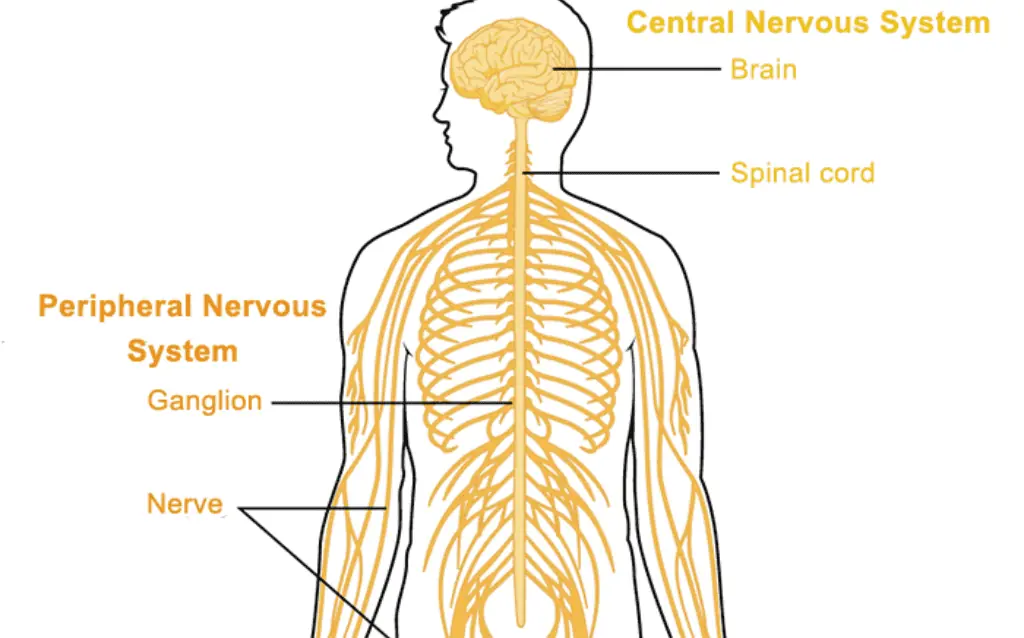
Science also explains the positive cardiovascular effects of forward bending poses. One study investigated the effects of different postural positions on cardiovascular and nervous system function. The position of forward spinal flexion — that is, forward folding poses — showed lower cardiac output, meaning blood pressure decreased.
This particular study also demonstrated how a forward bend pose like Paschimottanasana produces a calming, refreshing effect. Cells of the sympathetic nervous system are located in front of the thoracic vertebrae, so the spinal flexion when you fold forward stretches the sympathetic nerves. This explains why stretching the upper back and neck with poses like Seated Forward Bend helps you feel refreshed.
Energetic Aspects of Seated Forward Bend Pose
To go even deeper, we can explore the positive energetic or pranic effects of Paschimottanasana (Seated Forward Bend Pose).
To explain briefly, prana is the subtle life-force energy in yogic philosophy, similar to chi in Traditional Chinese Medicine. There are seven main chakras or energy centers in the body situated along the spine — from the base of the tailbone to the top of the head. Each chakra corresponds to a distinct function in the body and relate to specific emotions. When you feel “off” in some way, it may indicate a blocked or inefficient chakra. In the holistic sense, paying attention to how your chakras are functioning can give you insight into your physical and emotional health.

Seated Forward Bend Pose targets the three lower chakras:
- Root chakra, associated with feeling grounded, safe, and secure.
- Sacral chakra, pertaining to desire and creativity.
- Solar Plexus chakra, related to assertiveness, individual power, and uniqueness.
Seated on the floor, you are grounded through your root chakra. As you bend forward, the pranic currents rise throughout these bottom three chakras, also raising blood circulation to the abdominal organs. The solar plexus chakra is stimulated and digestive fire increases.
Based on these energetic principles, Seated Forward Bend Pose is reported to improve digestion and produce a calming effect on the body and mind.
How to do Paschimottanasana (Seated Forward Bend Pose)
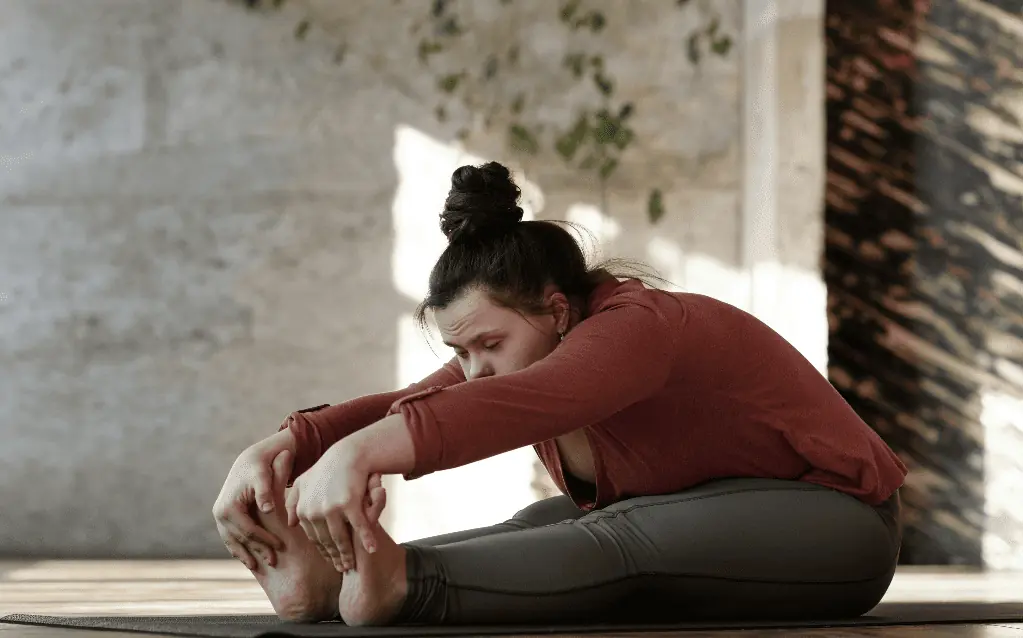
With all the amazing benefits of Seated Forward Bend Pose, you should absolutely add it into your regular practice! Follow these step-by-step instructions to experience it for yourself.
- Begin in Staff Pose (Dandasana), seated on your yoga mat with your legs extended at a hip width distance and the feet flexed. Sit tall and tilt your pelvis forward slightly so your are directly on top of your sit bones.
- As you inhale, reach your arms up and grow taller through the crown of your head to create space in the spine. Keep your shoulders relaxed down away from your ears.
- With your exhale, bring your torso forward, hinging from your hips to keep your spine straight. Keep your head in line with your spine so the back of your neck stays long.
- Leaning forward, try to bring your belly to your thighs. You may choose to hold here, with the spine long and straight.
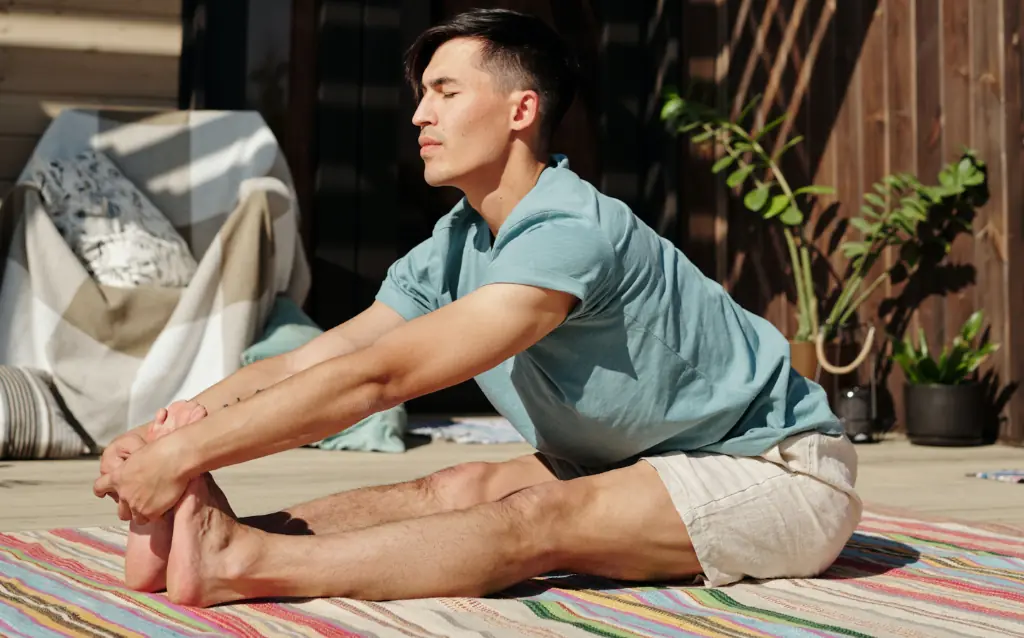
- When you can hinge from your hips no further, you may choose to completely bow forward over your lower body, rounding through your entire spine.
- Bring your hands to your feet, ankles, or shins — wherever they reach is fine! If you already have length in your hamstrings, you might loop the first two fingers of each hand around your big toes.
- Once you arrive in your fullest expression of Seated Forward Bend Pose, keep breathing slow and steady as you hold the stretch for 5-10 breaths.
- If you are rounded over, slowly roll up; if your spine is straight, return yourself to an upright seated position, then move on to your next pose.
If your goal is to increase flexibility in your hamstrings, repeat one or two more rounds of Seated Forward Bend Pose. Even if you aren’t able to touch your toes, regular practice of this pose will help keep your legs, hips, and back healthy.
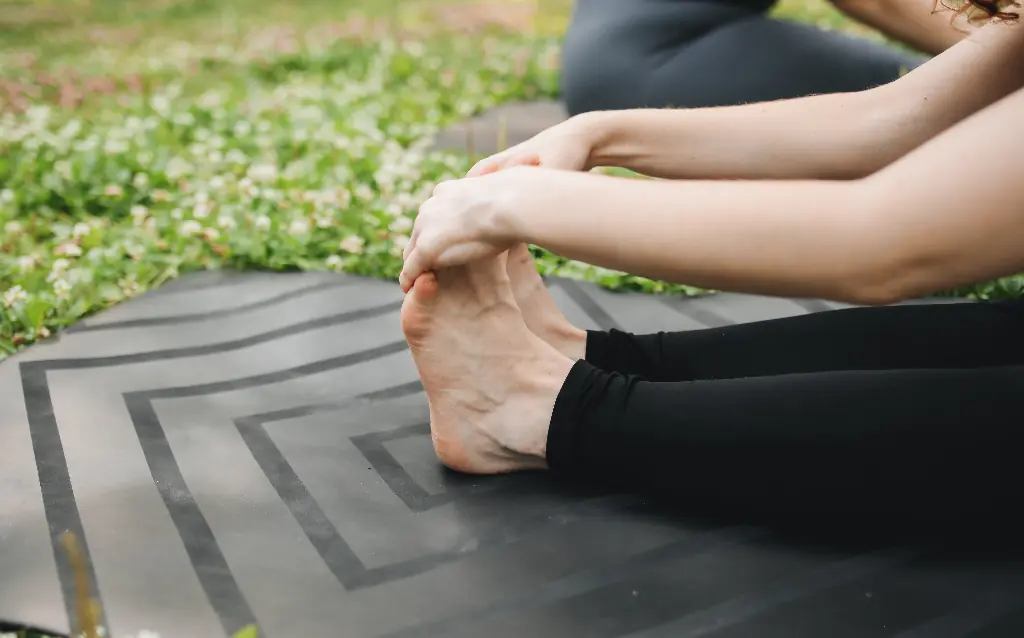
Pro-Tips and Alignment Cues
Refine your alignment to experience the maximum benefit of your Seated Forward Fold Pose with these tips! If you’re a yoga teacher, you can share these cues with your students to help them build body awareness.
- Tip #1: Activate your quad muscles by pulling up on your kneecaps, and turn your thighs inwards slightly. This will separate your sitting bones to release across your low back, and give you more room for your forward fold (especially if you have a larger midsection).
- Tip #2: Rather than thinking about bringing your head to your knees, aim to rest your belly on your thighs. This will help you keep your spine long as you fold forward.
- Tip #3: Don’t try to force your upper body to bend forward more than you’re able to in order to touch your toes — you’ll get the maximum benefit from this stretch if you listen to your body, rather than thinking about what the pose should look like or how far you should reach your arms.
Contraindications
In certain cases, this intense stretch might not be the best choice for your practice. If you are experiencing any of the following medical conditions, you should avoid Seated Forward Bend Pose.
- Lower back injury such as slipped or bulging disc, sciatica: forward bends that bring the spine into flexion will aggravate these issues.
- Pregnancy, in the 2nd or 3rd trimester: in order to practice a forward bend, you’ll need more space for the belly. Try the Seated Wide Legged Forward Bend variation described below.
- Diarrhea or stomach ulcers: bending forward puts pressure on the belly and abdominal organs, and might cause you more pain.
- Asthma symptoms: when leaning forward, the diaphragm and belly are restricted, reducing your capacity to breathe deeply, so it’s best to avoid forward bends until your symptoms subside.
How To Modify Seated Forward Bend Pose
The most common reason for modifying Seated Forward Fold is due to tight hamstrings. Try using one (or a combination) of these yoga prop modifications to safely practice this intense stretch.
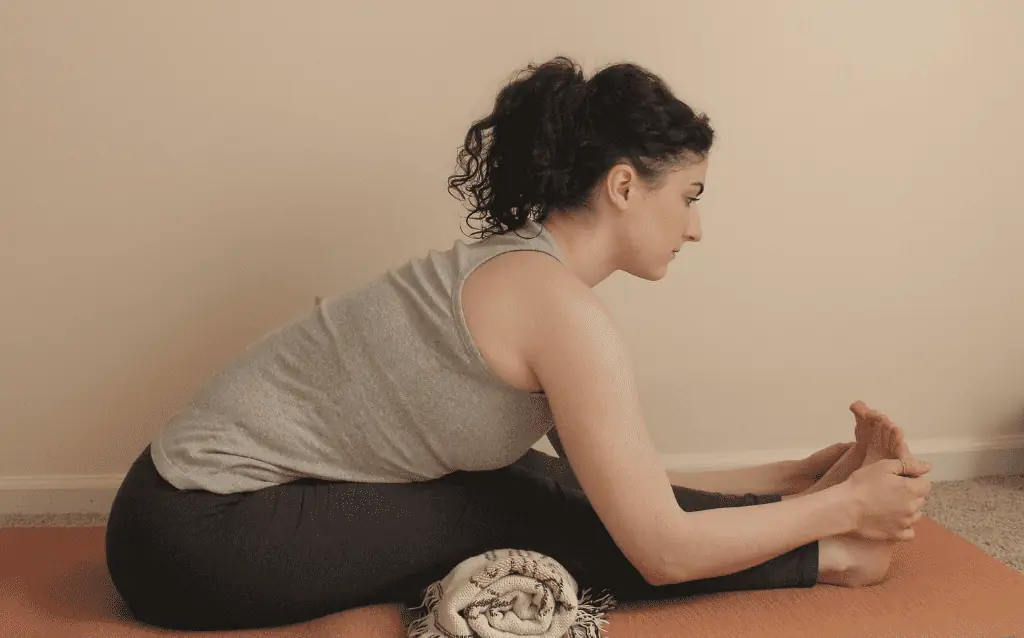
A blanket works wonders to prevent rounding the lumbar spine and pulling the lower back muscles. Sit on a folded blanket to elevate your hips, or place a rolled blanket under the knees instead of keeping the legs straight.
Another way to accommodate tight hamstrings is by using a yoga strap. Loop is around the bottoms of your feet and hold the ends in each hand. Gently pull the strap as you lean your upper body forward, striving to keep your spine long.
In the case that your hamstrings are already open and you want more of a challenge, place a yoga block against the bottoms of your feet. Then, as you bend forward and bring your belly to your thighs, grab ahold of the block just beyond your feet.
Paschimottanasana (Seated Forward Bend Pose) Variations
Just as there are many ways to modify Seated Forward Bend Pose for beginners, there are several options of related poses to challenge you as well.
Wide Legged Seated Forward Bend Pose
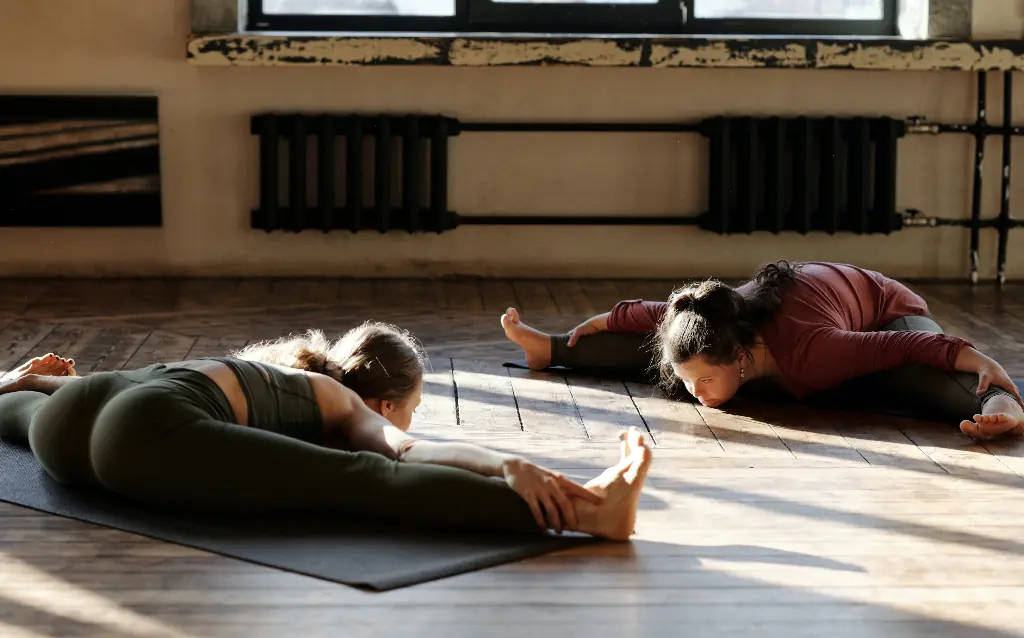
This is a great option for pregnant women, or anyone with a rounder midsection. It also provides a stretch for the inner thighs, in addition to the hamstrings.
- Sit on your yoga mat with your legs extended and separated as wide as possible without rounding the low back.
- Tilt your pelvis forward slightly so you are directly on top of your sitting bones.
- Flex your feet, and keep your toes and kneecaps pointing toward the sky.
- Sit tall and create space in your spine as you inhale.
- With your exhale, hinge from your hips and lean your torso forward. Walk your hands out in front of you as far as you can while keeping your back straight.
- Hold your Wide Legged Seated Forward Fold for 5-10 breaths. Then, walk your hands back in towards you to sit upright, and slide your legs together.
Revolved Forward Bend Pose
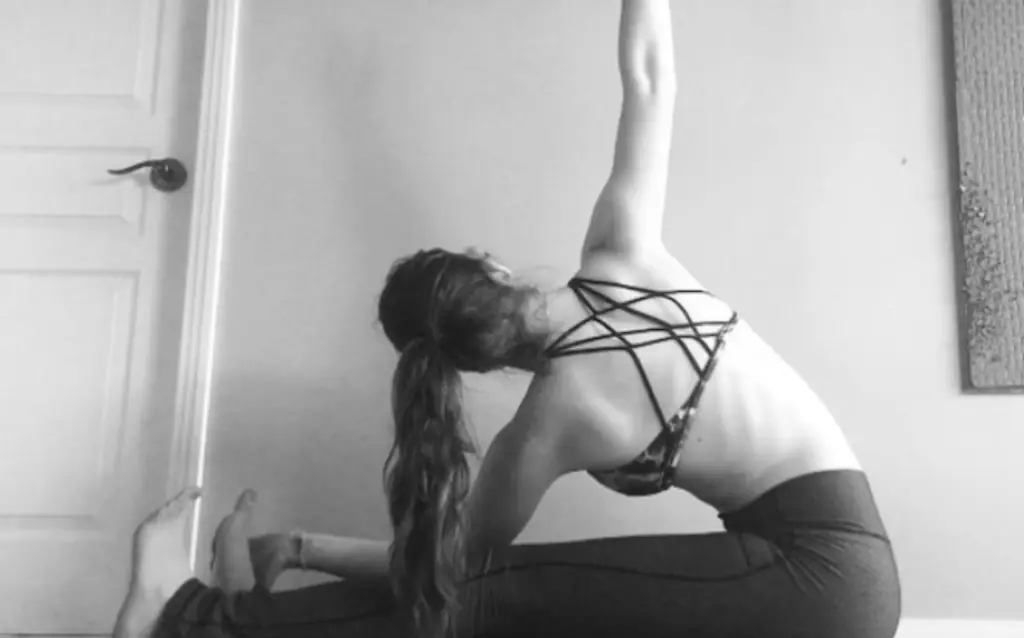
This version of Seated Forward Bend Pose adds a spinal twist for a great stretch in your torso.
- Begin in Staff Pose.
- Breathe in and reach your arms up, keeping your shoulders relaxed away from your ears.
- As you breathe out, lean forward and bring your left hand to the outer edge of your right foot. Reach your right arm up toward the sky.
- Hold your twist for a few breaths, then gently return to an upright seated position (Staff Pose).
- Repeat Revolved Forward Bend Pose to the other side, turning your body to the left with the right hand gripping the left foot, and left arm reaching up.
Seated Forward Bend Preparatory Poses
Obviously, it’s essential that you’re properly warmed up to properly stretch your muscles. Here are some preparatory poses we recommend in order to get your lower body ready Seated Forward Bend Pose.
Standing Forward Bend Pose
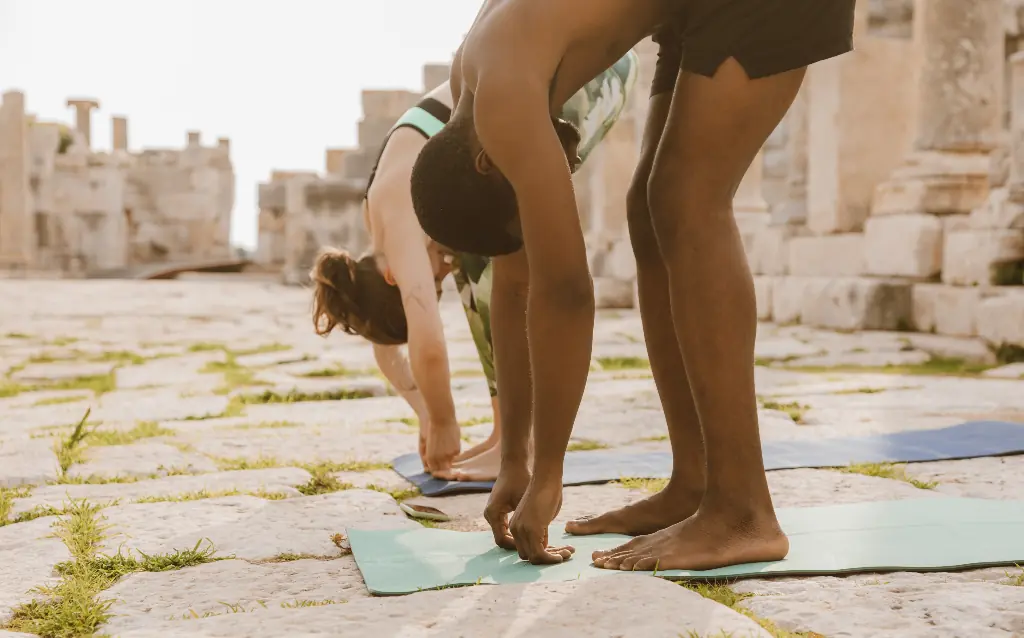
The standing version of this pose allows gravity to aid you in releasing your hamstrings.
- Begin standing in Mountain Pose with your feet separated at hip-width distance.
- Breathe in and reach your arms up. Lengthen through the crown of your head, creating space between your vertebrae.
- As you breathe out, dive forward, bending from your hips. Bring your hands to the floor if you can reach, or let your arms hang, taking hold of opposite elbows and let your torso hang.
- While bending forward, ground down through the outer edges of your feet and spin your thighs inwards slightly. This will spread your sacrum and help you release across your lower back, giving you a better stretch in your hamstrings.
- Keep a micro-bend in your knees if your hamstrings are particularly tight.
- Stay in your forward bend for several breaths, then slowly roll all the way up to stand.
Downward Facing Dog
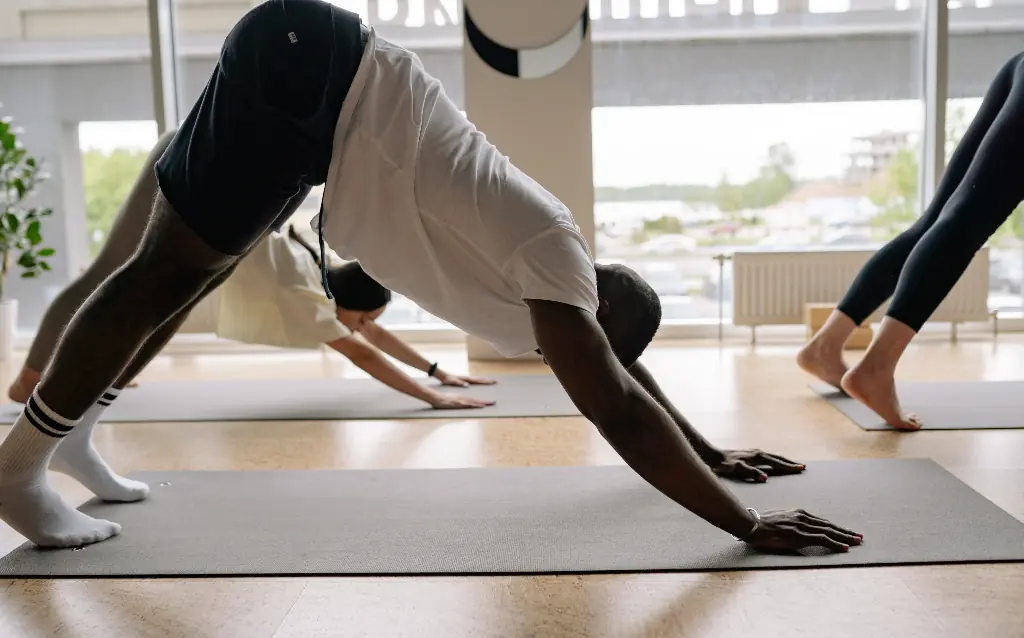
Down Dog will help open up the backs of your legs, from your heels to your hamstrings. It also creates length in the spine, which is helpful before doing forward bending poses. Need a refresher on proper form? Check out our Down Dog pose guide!
Staff Pose
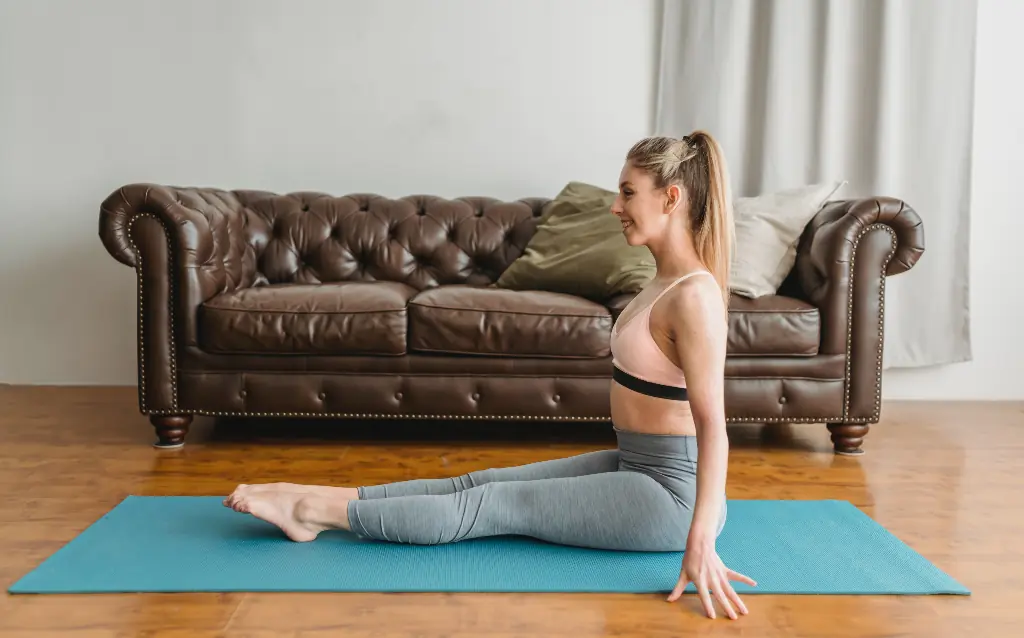
You can’t get into Seated Forward Bend Pose without first coming into Dandasana. This pose will set up proper alignment for your forward bend. Follow our detailed alignment cues and step-by-step instructions in our guide for Staff Pose.
Counter Poses to Follow Paschimottanasana (Seated Forward Bend)
There are many choices of follow-up poses after Seated Forward Bend. Here are some classic options!
Half Lord of the Fishes
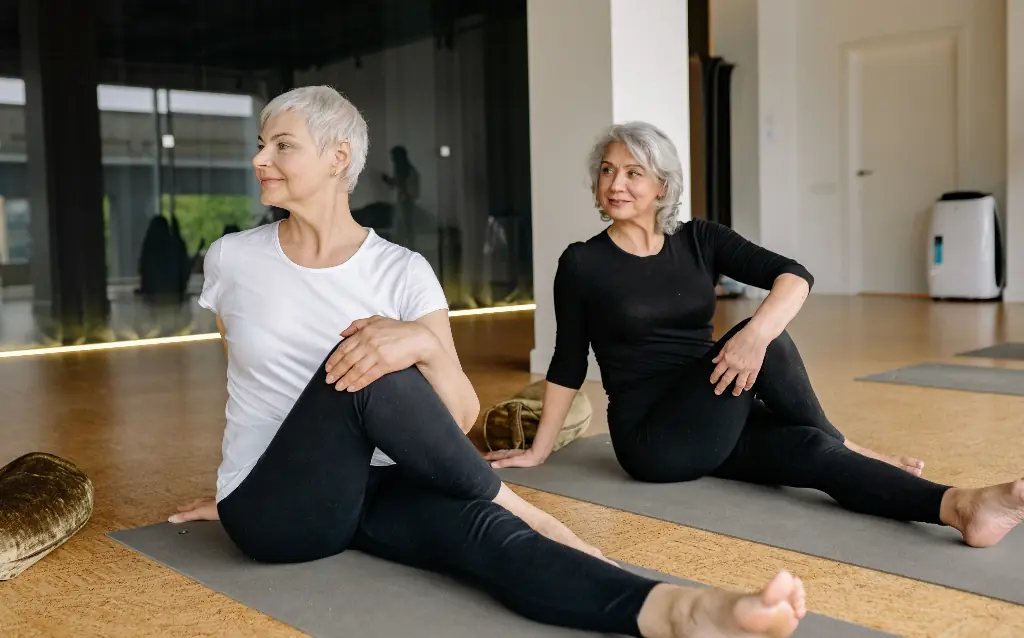
In Hatha yoga, this is the traditional counter pose to Seated Forward Bend Pose. The spinal twist will neutralize your spine after folding forward.
- Begin in Staff Pose, sitting tall with your legs extended and feet flexed.
- Bend your right knee and squeeze it in to your chest to soften your right hip and glutes.
- Cross your right foot over and place it down to the outside of your left thigh. Keep your right knee pointing toward the sky.
- Reach your arms up and lengthen your spine as you inhale. With your exhale, twist to your right.
- Hook your left elbow to the outside of your right knee and bring your right hand to the floor just behind you.
- Keep your right arm straight and press the floor away to keep your spine long.
- Hold your twist for 3-5 breaths, then gently release and return to your center.
- Repeat Half Lord of the Fishes on your other side, bending your left leg and twisting to your left.
Bridge Pose
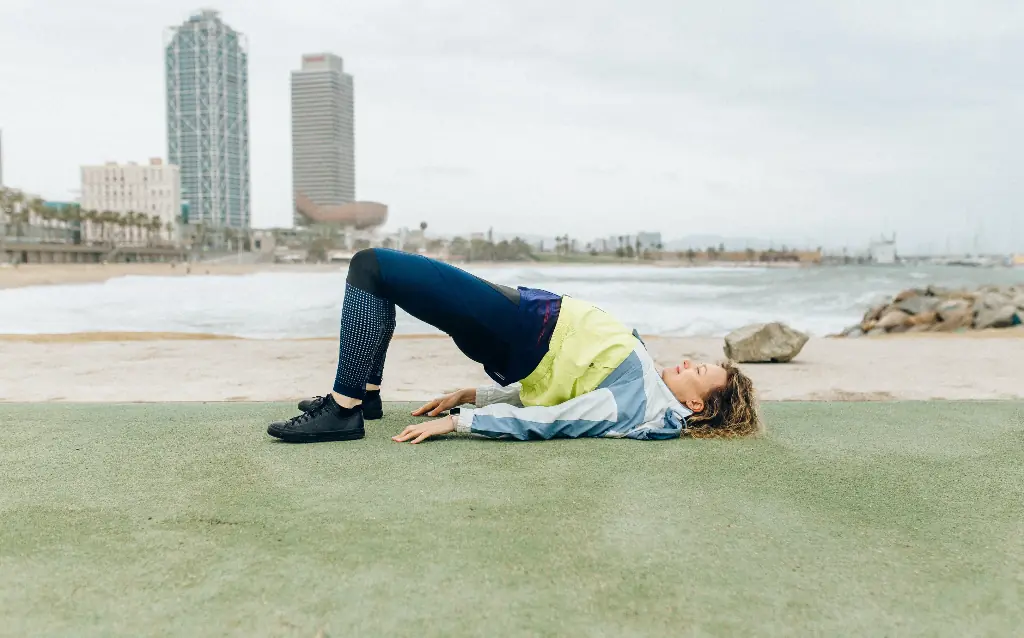
In forward bending poses, your hips and spine are in flexion; so, a yoga posture like Bridge Pose that lengthens the front side of the body while extending the spine is a great option for a follow-up pose. Check out our Bridge Pose guide for instructions and proper form.
Corpse Pose
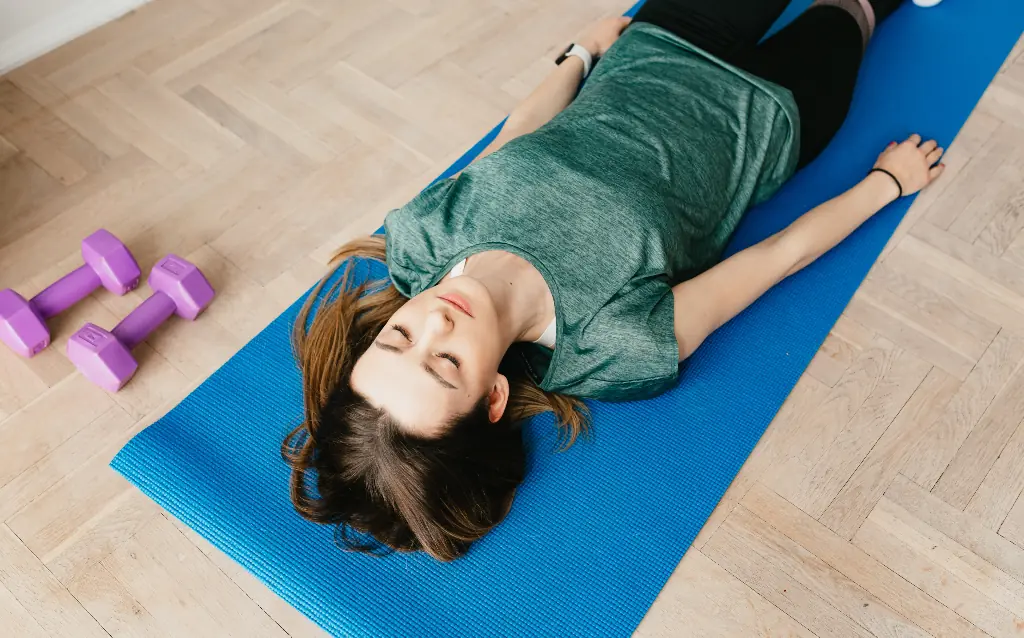
Seated Forward Bend Pose is known to be a calming and relaxing yoga posture. So, transitioning into Savasana after Paschimottanasana is another excellent choice. From your seated position, slowly lower down to your back and let your whole body relax. To really get the most out of your Savasana at the end of your yoga practice, be sure to read our Corpse Pose guide.
Seated Forward Bend Frequently Asked Questions
I can’t touch my toes or straighten my legs all the way – am I doing something wrong?
Not at all! The aim of Seated Forward Bend is to stretch the back body, especially the hamstrings. If you are very tight, it’s actually more effective and safe to keep the knees bent. Even if your hamstrings are relatively open, there are other factors that might keep you from touching your toes, namely body proportions. If you have longer legs and a short torso, touching your toes will prove more difficult. Remember the intention of the pose, rather than holding onto an idea of what it “should” look like.
I feel pain in my lower back. What should I do?
To avoid feeling any pain or pulling in your lower back, review the modifications section of this article. Using props can be a huge help in preventing injury and discomfort. As a general rule, if you feel pain in the lower back in forward bending poses, keep your knees bent.
How long should I hold my Seated Forward Bend?
To give your muscles enough time to gently lengthen, aim for 5-10 breaths in your Seated Forward Bend. If you are taking a restorative approach to this pose to relieve stress, you can stay in the pose for 2-5 minutes. In that case, it would be helpful to use some yoga props to make sure you are supported and comfortable. Use a blanket or two as mentioned in this article, and maybe even add a bolster across your lap to rest your torso on.


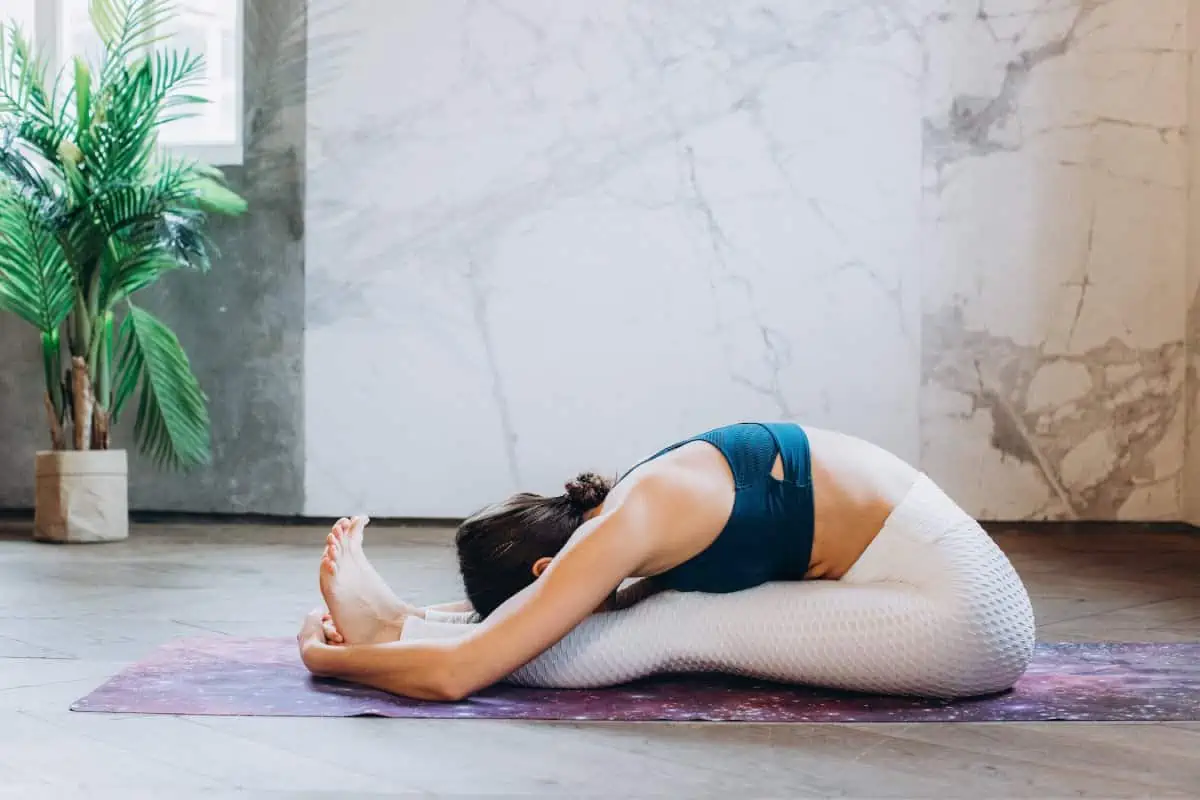
Excellent article on Paschimottanasana and other poses. I will be very much thankful to you if you can send me a few tough asanas to control my Blood sugar . I am a regular practitioner of Yoga and I am 63 years and diabetic for the last 40 years